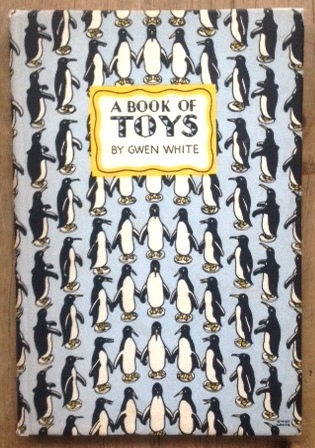Inspiring Young Readers
 posted on 21 Dec 2018
posted on 21 Dec 2018
A Book of Toys by Gwen White
Gwen White’s A Book of Toys was published in 1946 as part of the King Penguin series that had a pretty short life span of just twenty years between 1939 – 1959. When the new initiative was announced by Penguin Books founder, Allen Lane, he said:
“These have not been planned to coincide with the public's growing appreciation of art, but rather to appeal to the general liking for illustrated keepsakes of special projects. For this reason they are specialised ... often dealing with by no means broad subjects, such as the History of British Military Uniforms, The Stone Carvings at Southwell Cathedral, Poisonous Fungi and Romney Marsh. The original idea for King Penguins came from the small Insel-Verlag books which were published in Germany before the war. Why, we felt, should there not be a similar series of books in this country? The experiment, started a few weeks after war broke out, turned out to be successful. One of the most distinctive features of this series is their decorative covers.”
I have seen plenty of the other titles in this imprint but none of them seem quite like this one. A Book of Toys is a gloriously eccentric little confection that has children as its main audience but also, I suspect, has one eye to adult readers at the same time. The book is presented as a sort of chronological survey of children’s toys from around the world starting as far back as 3000BC and coming through to the 20th century.
She uses toys on public exhibition at various London museums as her source material and provides a bit more information about where they can be found in two or three pages at the end. But in truth, the real pleasures of this book are twofold – White’s charmingly naïve drawings that have an almost primary school feel to them and her accompanying text which veers around from prose to verse, from straight descriptions to unexpected analogies. Perhaps the most striking characteristic of her descriptions is the decision to speak directly to her reader:
“Now come the fearsome beasts. The first is a growing mastiff from Egypt.
His name sounds grisly, it is Molassian Hound.
The lion is smiling because he likes you, but the other lion is very fierce indeed.”
The illustration for a 13th century toy – a sort of knight on horseback – sees White suddenly change tone with the caption underneath reading:
“Oh I am so strong,
And go bouncing along,
Hippity, Hoppity, Hop!
My wheels are not round
As I touch the ground
Clippity, Cloppity, Clop!
And light is my head
Although made of lead
Floppity, Floppity, Flop!”
There’s plenty more of this kind of stuff here and the cumulative effect is surprisingly seductive and oddly comforting. Alongside the bright, fresh colours used for the illustrations, it’s easy to see why this book would have been a popular one for parents to read with their younger children – and to use as inspiration for a day out to go and actually see the toys in their museum settings.
I haven't had much success in finding out too much about Gwen White - as I've found with other authors and illustrators from this period, there isn't a lot of easily found biographical information or critical assessment. I'm not the only one who has struggled in this task and I found an appreciation of another of her books - Gwen White's Pictorial Perspective - where the blog author, Margaret Chodos- Irvine was also forced to say:
"I tried to find out more about Gwen White, but there doesn’t seem to be much on her that is easily accessed. She did illustrate children’s books, and authored a book about patterns as well as others about dolls and toys. She was also a painter who exhibited at the Royal Academy and was ARCA (Associate Royal Cambrian Academy)."
So we may not have lots of background detail but we do at least still have the book. However, copies of these King Penguins are getting harder and harder to find in decent condition – books like these were often used and abused and so limited numbers survive. You can find copies on the second hand market and you’ll pay something like £15 for a decent edition. Penguin collectors, children’s book collectors and lovers of the plain quirky will be tempted I suspect.
Terry Potter
December 2018
(Click on any image below to view them in a slide show format)




